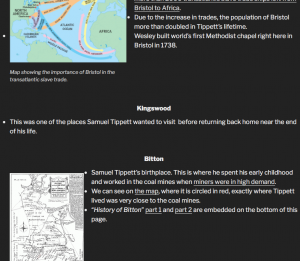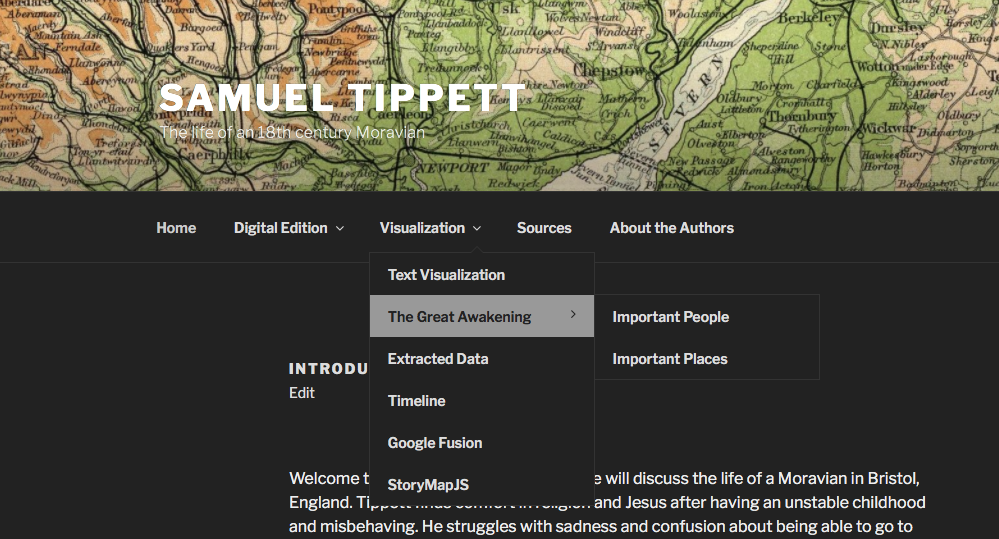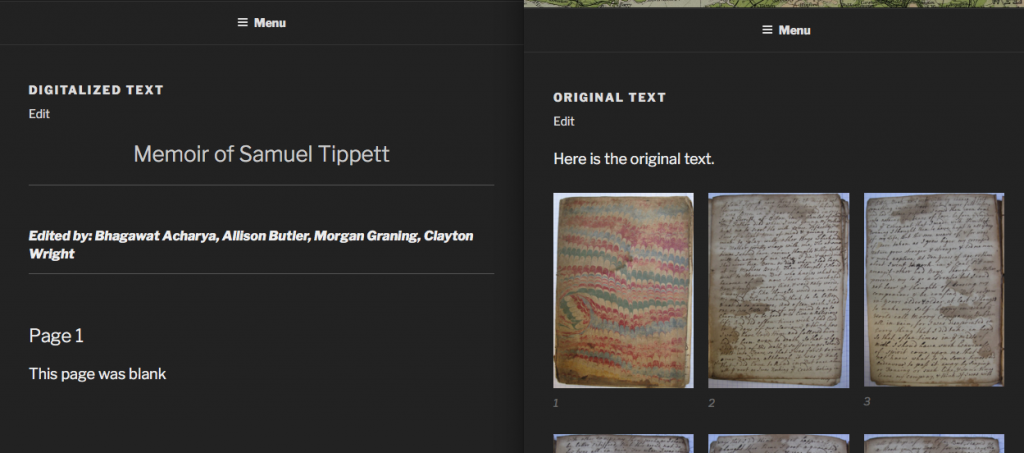http://tippetthumn100.blogs.bucknell.edu
For our final project, we created a website to show the various aspects of the life of Samuel Tippett. To show these different aspects, we had to pull together everything we did throughout the year and do more research to be able to answer our research question, “How did religion give Samuel Tippett and others during this time a new life?”. When we though of this question, we were only concerned about Tippett but as we looked further into the time Tippett lived (1710s to 1780s), the places he lived in (Bristol, Kingswood, Hanham…) and the people who he interacted with (Wesley, Whitfield, Cennick…) , it was clear that there Tippett was not the only one who was becoming religious. He was not the only one finding Jesus as the answer to the problems he faced in his life. It appeared to be more of religious movement. It was in fact the First Great Awakening, which revitalized Christianity in Great Britain and the colonies.
To try to answer our question, we had to research more about the First Great Awakening, how Tippett and others related to it. We first reread what Tippett wrote to try to understand more of what he is saying. Although this reading helped gain slightly more knowledge about the life of Tippett, it was not as much as we were hoping. We tried to translate Tippett’s words to something we would understand but we realized that “no translation is complete until the original source is expressed in another language (Anne Kelly Knowles).” and we did translate it into a (programming) language (XML) so we could extract the data. During our markup process, we came up with group rules to determine whether or not something should be marked up. We then gathered all the information we had collected. We looked through the graphs, the text visualization tools we used, the StoryMap and the timeline we created. All of these tools helped us visualize Tippett’s life and made it simpler for us to understand him. As Whitley said, “…the mind is just as capable of extracting meaning from shapes and patterns as it is at processing written language.(193)” We included links to and embedded the tools we used to visualize the memoire.
Then we decided to learn more and research the Great Awakening. John Wesley played a very important role in the Awakening. Although he was not a Moravian for that much of his life, he was greatly impacted the Moravian moment and the christianity moment as a whole. According to the Wesley Cottage site, he travelled to America in the hopes of turning the Native Americans to Christianity but ultimately left to go back to England, where he joined the Moravian group. Wesley, with some initial encouragement from Whitfield, started doing “open air” preaches, which allowed anyone and everyone to attend. His first (or second, as Tippett mentions) “open air” preach was heard by the working class people of Kingswood. Wesley was publicly against slavery during the time of the slave trade. Whitfield was associated with Wesley very early, old Oxford friends, and decided to preach. He preached for several different type of Christianity. Whitfield also decided to go abroad and preach there, but it turned out to be a failure so he came back and began preaching again. He preached more than 18,000 times.
 To help us with organizing all of our research points, we used the extracted data to sort out the place and people name. On the website we described the more important places, such as Tippett’s birthplace Bitton and Bristol. We researched different places as well to help us determine how these places influenced the people at the time. Whitfield began his open air preaching in Kingswood. Bristol had a gathering of about 3000 people for one of Whitfield’s preachings. The images include in the pages make it easier to see and understand the concept of each pages easier.
To help us with organizing all of our research points, we used the extracted data to sort out the place and people name. On the website we described the more important places, such as Tippett’s birthplace Bitton and Bristol. We researched different places as well to help us determine how these places influenced the people at the time. Whitfield began his open air preaching in Kingswood. Bristol had a gathering of about 3000 people for one of Whitfield’s preachings. The images include in the pages make it easier to see and understand the concept of each pages easier.
As creating a website was new to us, we faced many challenges and we overcame most of them. Most of these challenges were because we were not familiar with WordPress and we had to figure out how to use it as we added new elements to our site. We had problems towards the beginning with pages vs blogs but we figured it out quickly and continued to work on the site. Another problem we ran across was the amount of research we did. We researched the relation between the people and places. The places Tippett stayed at throughout his life had a lot of history behind them and sometimes the research went too far in-depth. With the time constraints, we could not go too in-depth with each of the places he visited.
 Our design for the website was simple and elegant. We created drop-down menus (as seen on the picture to the left) to make it easier for the users to navigate. We included all the elements of our previous projects as well as descriptions for them. We embedded our Voyant tools our XML extracted data, our TimelineJS, our GoogleFusion table and our StoryMapJS. We chose to use the map as our big homepage picture because the map shows Bitton, where Tippett is from.
Our design for the website was simple and elegant. We created drop-down menus (as seen on the picture to the left) to make it easier for the users to navigate. We included all the elements of our previous projects as well as descriptions for them. We embedded our Voyant tools our XML extracted data, our TimelineJS, our GoogleFusion table and our StoryMapJS. We chose to use the map as our big homepage picture because the map shows Bitton, where Tippett is from.

The image above is also another problem we faced. I wanted to have a page like the Transcription Desk, where a user could read the digital and the original text side by side. I was not able to do it so we had to stick to doing one page for Digital and another for Original.
Through all of the tools we linked and embedded on the website, through reading the memoire, we were able to answer our research question as well as allow users to answer it by browsing around our site. Religion gave people hope that they never had before, it gave them hope for a better life and afterlife. It gave them the hope to redeem themselves, especially true in Tippett’s case. This time period also gave church access and preachings to the working classes, whereas before, listening to preaching was not possible for them.
Bhagawat Acharya is a Computer Science major at Bucknell University. He is interested in working at a cyber security firm after graduating from Bucknell University in 2020. Currently, he is a junior fellow for the Discovery Residential college.



